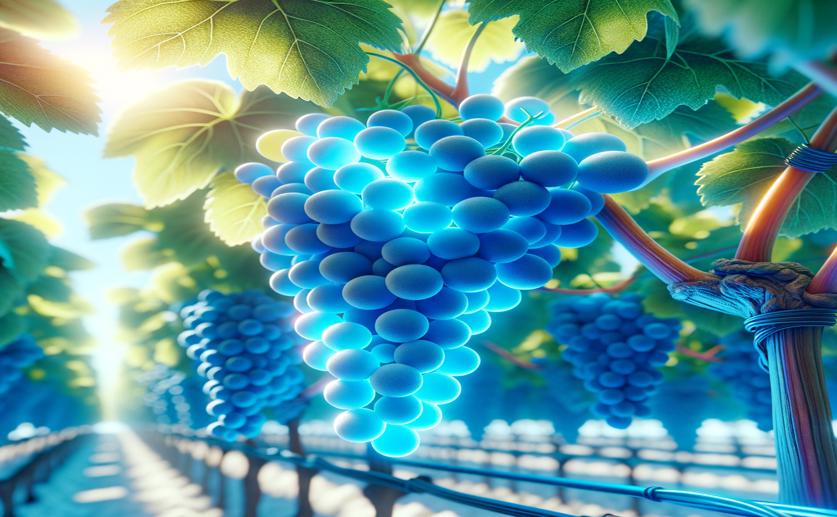
Image Source: Natural Science News, 2024
Key Findings
-
The study by the Chinese Academy of Sciences found that blue LED light during the day (8:00 to 18:00) accelerates grape berry coloration and increases anthocyanin content
-
Blue LED light at night (20:00 to 6:00) did not significantly enhance anthocyanin accumulation compared to the control
-
Daytime blue light exposure boosts the expression of genes related to anthocyanin biosynthesis and light signaling, suggesting a regulatory mechanism influenced by light conditions
Anthocyanins are pigments responsible for the red, purple, and blue colors in many fruits, including grape berries. These pigments are not just important for the aesthetic appeal of the fruit but also for their nutritional benefits, contributing to the antioxidant properties of grapes. Understanding how to optimize anthocyanin accumulation in grape berries can have significant implications for agriculture and food science. Recent research conducted by the Chinese Academy of Sciences has shed light on how the timing of blue light exposure affects anthocyanin accumulation in grape berries[1].
The study aimed to determine whether supplementing monochromatic blue LED light during different periods of the day would influence the accumulation of anthocyanins in grape berry skins. Two treatments were tested: one where blue light was supplied during the day (Dayblue) from 8:00 to 18:00, and another where blue light was supplied at night (Nightblue) from 20:00 to 6:00. The results showed that the Dayblue treatment accelerated berry coloration and increased total anthocyanin content more rapidly than both the control (CK) and the Nightblue treatment. In fact, the Nightblue treatment did not significantly differ from the control in terms of anthocyanin accumulation.
The findings from this study align with earlier research that highlights the importance of light in flavonoid biosynthesis. For instance, previous studies have shown that light conditions significantly impact the expression of genes involved in the flavonoid biosynthesis pathway in grape berries[2]. Specifically, low temperatures combined with light were found to enhance anthocyanin accumulation, whereas high temperatures or darkness suppressed it. This suggests that light not only plays a crucial role but also interacts with other environmental factors like temperature to regulate anthocyanin biosynthesis.
Moreover, the study's qRT-PCR analysis revealed that the Dayblue treatment slightly improved the relative expression of the anthocyanin-structural gene UFGT and its regulator MYBA1. This is consistent with earlier findings that specific genes in the flavonoid biosynthesis pathway are regulated by light conditions[2]. The study also found that the expression of light-reception and signaling-related genes such as CRY, HY5, HYH, and COP1 rapidly increased under the Dayblue treatment. This is particularly interesting as it ties back to earlier research on the role of transcription factors like HY5 in light-regulated gene expression[3].
In Arabidopsis, the transcription factor HY5 binds to the G-box element in light-regulated promoters and interacts with the circadian clock protein CCA1 to regulate gene expression[3]. This interaction is crucial for the normal circadian rhythmic expression of light-harvesting chlorophyll a/b (Lhcb) proteins. Although the current study focused on grape berries, the increased expression of HY5 under Dayblue treatment suggests a similar regulatory mechanism might be at play, where HY5 could be enhancing the expression of genes involved in anthocyanin biosynthesis in response to blue light.
Additionally, the study's findings contribute to our understanding of how circadian rhythms might influence anthocyanin accumulation. Previous research has shown that the circadian clock regulates gene expression in plants, adapting them to 24-hour changes in environmental conditions[4]. However, the role of the circadian clock in developing reproductive organs like grape berries is less understood. The current study indicates that the timing of light exposure, aligned with the plant's circadian rhythms, can significantly impact anthocyanin accumulation, thereby offering a practical approach to optimizing fruit quality.
In conclusion, the study by the Chinese Academy of Sciences demonstrates that supplementing monochromatic blue LED light during the day, but not at night, promotes early coloration and improves anthocyanin accumulation in grape berry skins. This research not only builds on previous findings about the role of light and temperature in flavonoid biosynthesis[2][5] but also suggests potential regulatory mechanisms involving light-reception and signaling-related genes[3]. These insights could have practical applications in agriculture, especially in controlled environment agriculture systems where light conditions can be precisely managed to optimize fruit quality.
TrendForce 2024 Global LED Lighting Market Analysis
Release Date: 01 February 2024 / 31 July 2024
Language: Traditional Chinese / English
Format: PDF and Excel
Page: 90-100 / Semi-Annual
|
If you would like to know more details , please contact:
|












